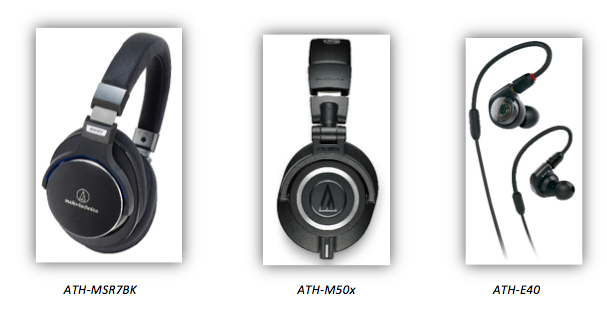Question: What is a dynamic speaker driver?
Answer: Headphones use different types of speakers (referred to as drivers) that vary depending on the size of the headphones and the quality of sound they are designed to reproduce. Most headphones use dynamic speakers (the type people generally think of when they think of speakers) wherein the electrical energy of an audio signal, which includes positive and negative cycles, is carried to the speakers via cables and is translated into physical energy by the speaker’s vibrating diaphragm. The vibrating of the diaphragm creates sound pressure waves which the human ear detects as sound. The human ear acts the same as a microphone in this sense. Dynamic speakers use the same concept as dynamic microphones, just in reverse, by taking electrical energy and creating physical energy. Many popular Audio-Technica headphones, including the ATH-MSR7BK and ATH-M50x, offer dynamic drivers.
 Dynamic speakers/drivers are used in a variety of devices, often requiring that they be altered to fit the application. Large PA speakers, for instance, generally have large diaphragms that can produce loud, low frequencies. As you would imagine, the bigger the speaker, the bigger the sound waves that can be created. This is easily demonstrated by sub speakers, which are commonly larger than other speakers and are specifically designed to produce lower frequencies. When speakers need to be smaller, as in the case of headphones, the power and frequency response may need to be altered. The power is not altered too much since the driver is going to be closer to the ear and so does not need to put out as much energy. However, the response may need to be engineered to get the desired lower frequencies from the smaller-sized speakers. Engineers use different techniques to overcome the size limitations and achieve this lower frequency reproduction.
Dynamic speakers/drivers are used in a variety of devices, often requiring that they be altered to fit the application. Large PA speakers, for instance, generally have large diaphragms that can produce loud, low frequencies. As you would imagine, the bigger the speaker, the bigger the sound waves that can be created. This is easily demonstrated by sub speakers, which are commonly larger than other speakers and are specifically designed to produce lower frequencies. When speakers need to be smaller, as in the case of headphones, the power and frequency response may need to be altered. The power is not altered too much since the driver is going to be closer to the ear and so does not need to put out as much energy. However, the response may need to be engineered to get the desired lower frequencies from the smaller-sized speakers. Engineers use different techniques to overcome the size limitations and achieve this lower frequency reproduction.
For in-ear monitors (IEM), which have become popular for casual listening as well as stage and studio use, the smaller drivers in headphones needed to be reduced in size even more. One technique engineers created is referred to as “push-pull,” which utilizes two very small dynamic drivers positioned face-to-face. By moving in conjunction with each other but in opposite directions, these two small drivers are able to move twice as much air as a single driver would, resulting in better low-frequency response. While one driver is “pushing” the air in its positive state of the frequency, the other driver is “pulling” the air in its negative state of the frequency. The result of having two drivers that work together is a low-profile headphone package that can still produce robust low frequencies. This push-pull technology is found in the ATH-E40 IEM, which are growing in popularity among onstage bass players and other musicians who require IEM with a wide bass response.
Next week, we’ll look at balanced armature drivers, which are designed for even better frequency response and can be even smaller! Feel free to contact our Audio Solutions Department for any additional questions.
















































































































































.webp)































